Green, Greener, Greenest: Graphic designers strategies for deconstructing green claims
by: FEED STOP, 2011-08-07 13:00:00 UTC
I have developed a list of twenty one key factors for analyzing green claims, for use by my graphic design students at New Mexico State University. The list’s purpose is to help them develop sensitivity to the subject in order to produce more critical work. The impetus for creating it stems from events in 2007 when the Advertising Federation, an industry group in the U.S. fell short of actually recommending that the Federal Trade Commission institute new guidelines limiting green claims in advertising, branding and packaging. Despite the voluntary nature of the proposed guidelines large advertising firms resisted the possibility [...]
WeWood Chrono Watch
by: EnviroGadget, 2011-08-31 09:00:35 UTC

The WeWood Chrono Watch is formed from offcuts of wood that often go to waste. The watchmakers use as much wood as possible to create a unique looking, stylish watch.

The WeWood Chrono Watch has been created to make use of wood that would otherwise go to waste. The strap and case are made entirely from organic, hypo-allergenic wood, great for those who have sensitive skin and have problems with more traditional watches. The watch features both an analogue and a digital display and is able to be set to different time zones. The watch has a stopwatch, alarm, light and day/date functions and uses a Miyota quartz movement.
The WeWood Watch is available in two colours, brown and black. The brown watch is created from red wing celtis wood which gives it deep warm colour. This type of wood is commonly used as flooring, it is from the left over scraps that the watch is formed. The black watch is created from ebony, giving it a rich sleek look. Making use of wood that would otherwise go to waste is clearly an environmentally sound idea, to add to their green credentials WeWood plants a tree for every watch purchased. The WeWood Watch is a unique watch that is sure to please any woodwork enthusiast, eco warrior, or those with sensitive skin.
Want to buy this gadget? Check out the WeWood Chrono Watch article on EnviroGadget to see the lowest prices for this gadget.
© 2008 to 2011 EnviroGadget.com. You can now keep up with the latest eco-gadgets on the EnviroGadget Facebook page. Why not help us to spread the word?
Related posts:
- Citizen Men’s Eco-Drive Perpetual Calendar Chronograph Watch – BL5250-02L
- Pathfinder – Multi-Band Solar Atomic Digital Watch For Men By Casio
- Ladies Solar Powered Ana-digi Watch By Casio


 Collecting Water in the Sky
Collecting Water in the Sky
by: Yanko Design, 2011-08-31 07:01:20 UTC
Skydrops is a helium inflated balloon designed to collect water by harnessing Mother Nature’s own energy. Spinning in the wind creates energy used to cool metallic sheets with peltier cells within the balloon. As the air passes through the cooled surface, water begins to condensate, and becomes a liquid before falling through a cable to a reservoir at the ground. Designed to fly uninterrupted for up to 2 months, the Skydrop will be able to create up to 50 liters every day.
Designer: Guilherme Rodrigues & Murilo Gomes

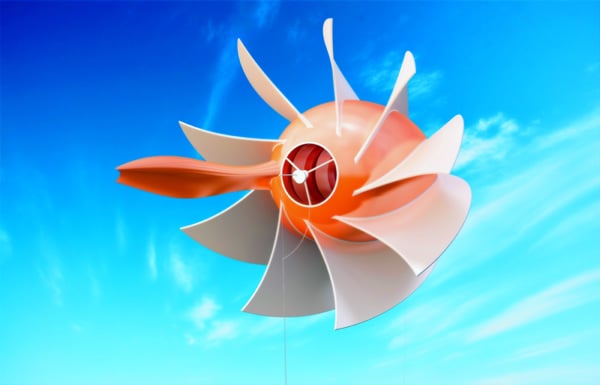
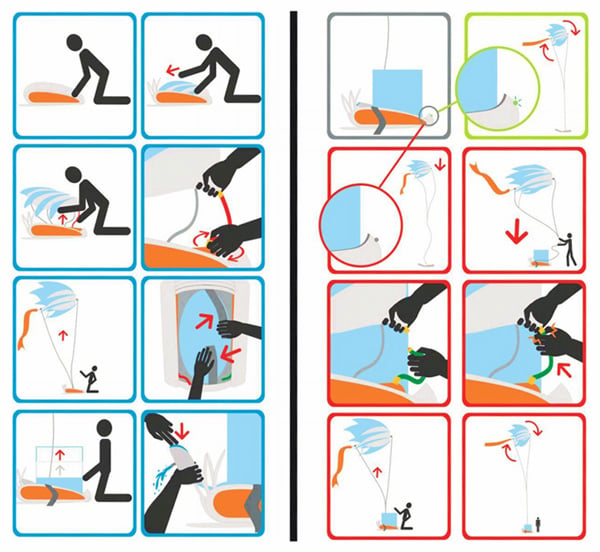
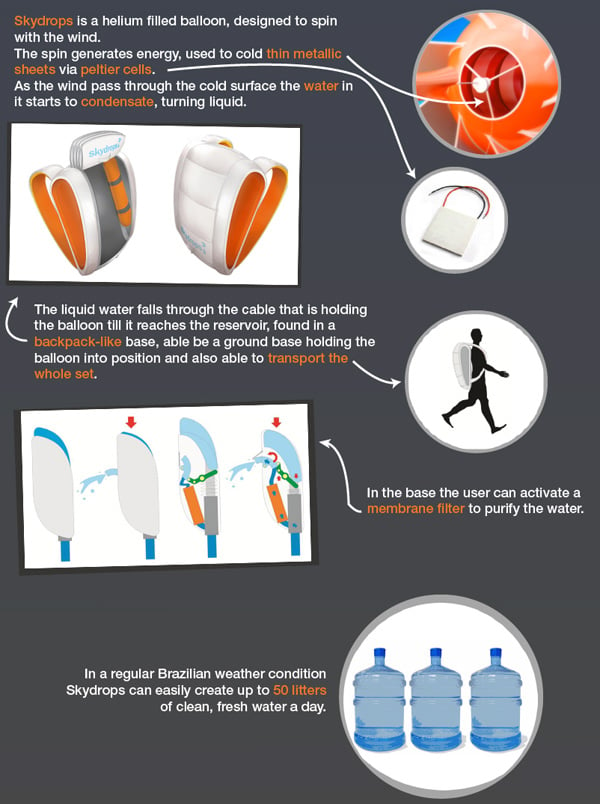
----------
Yanko Design
Timeless Designs - Explore wonderful concepts from around the world!
Yanko Design Store - We are about more than just concepts. See what's hot at the YD Store!
Technology promises to capture energy of human motion to power portable electronics
by: Ecofriend, 2011-08-31 08:40:47 UTC
Ankit Sharma:

Portable ElectronicsElectronics could soon be powered by human gait
All those fitness conscious people on earth, what if your running gave you much more than just burning calories? What if I tell you that in the not so distant future, you can charge your portable electronic devices by just burning the sole of your running shoes. Surprised, I am certainly not pulling your leg here, actually two engineering researchers at University of Wisconsin-Madison, Tom Krupenkin and J. Ashley Taylor have had a vision of such a device, and they’ve presented a paper on it. So, with their invention coming, your battery may discharge while on a run, but your phone’s battery will last forever. Read on and feel charged up.
What’s is it?
Human body is a power house of energy and research has proven that a good sprint can produce a kilowatt of energy, enough to power a house. But, all this energy cannot be harnessed. But, if a small amount can be, then it will be enough to power your electronic devices like mobile phones, music players etc. Energy from the sun is also a good source of free power but it is not available 24×7. While for this, you just have to take a saunter. According to Krupenkin, currently there are not enough technologies in the watts range, they are either aimed at large scaled power harvesting, like wind or solar, or small power applications, like calculators.
In their paper published in Nature Communications, Tom Krupenkin and J. Ashley Taylor allude to this technique by the name ‘reverse electrowetting.’. The initial development for this project was funded by National Science Foundation Small Business Innovation.
Methodology:
Mechanical energy is generated whenever we walk, run, or do anything with our feet. This mechanical energy is what the researchers envision to trap. The mechanical energy is converted into electrical energy by using a transducer which is essentially a micro fluidic device which consists of thousands of liquid micro-droplets which interact with a nano structured state. The device could be embedded into the footwear which stores the energy and can convert it to 20 watts of electrical power. And this device never needs to be recharged as this works in real time. It creates, and generates simultaneously.
Usage:
You don’t have to rely on chargers anymore. Now, you can keep yourself fit, and simultaneously enjoy your playlist without worrying about those little battery bars on your device.
Future:
Currently, wires have to be attached to the transducer and to the device in question, but Wi-Fi can make things easier. Wi-Fi hotspots installed with the transducer will enable the user to charge their device without having to go through the pain of handling all those worrisome wires.
Via: Science Daily


 10 concept computers promising a green future of computing
10 concept computers promising a green future of computing
by: Ecofriend, 2011-08-31 08:42:41 UTC
Puja Bhardwaj:

Concept LaptopConcept Laptops Promise Green Future of Computing.
We all have a role to play when it comes to saving the environment and the best way in which we can contribute our bit is by purchasing eco-friendly gadgets and devices. Technology is ever-changing and expanding and so any device which is new today will become obsolete tomorrow. Thanks to the advancements happening in the area of information technology, new computers enter the market and soon remain nothing more than a piece of junk. This is precisely why a new area of computing has emerged, which is popularly known as Green Computing. The technology encourages people to use computers as well as accessories that are environmentally-friendly and that cause little or no harm to the environment during their usage or when they are disposed off.
Here, take a sneak peak at the 10 concept computers that promise a green future of computing:
1. Recyclable paper laptop

Recyclable Paper LaptopRecyclable Paper Laptop
One of the most environmentally friendly computers that you can think of purchasing is the Recyclable Paper Laptop. This concept laptop is crafted from papers that have been recycled or pulp materials that are essentially packed in layers. Consumers, especially tech geeks keep looking for newer and latest models of computer and junk the old machines by dropping them into landfills. This further adds to the e-waste items. By purchasing the Recyclable paper laptop, you won’t have to worry about repairing it as well as it is comparatively easier than the traditional laptops. Besides, the damaged parts of these laptops can be easily replaced with newer ones and then sent across for recycling.
2. IMEC laptop

Solar Powered LaptopSolar Powered Laptop
This unique laptop can be easily powered using just two solar cells and encourages people to understand the importance of solar energy or alternative energy. This prototype laptop has been designed by industrial designer Jan Leyssens and runs completely on solar energy. It is popularly known as the “IMEC Meets Howest” computer and combines the mobility feature of the laptop with solar cells capable of generating renewable energy.
3. Lifebook Leaf multipurpose laptop

Life Book Leaf LaptopLife Book Leaf Laptop
This innovative gadget has been designed using the new environmentally-friendly technology that will further help in revamping laptop productions in future. The idea of designing such a concept based laptop came to designers Carl Burdick and Laura Karnath who were competing for the “Fujitsu Design Award - A life with future computing”. Some of the other exciting features of the gadget include OLED touchscreen that spreads out easily and can be conveniently folded as a laptop. Its exterior is carved out of polycarbonate, which is optically sensitive material and shatterproof as well.
4. LOOP – Ecofriendly desktop computer

Dell Loop LaptopDell Loop Laptop
This device is the creation of industrial designer Jocko Chan who has made a conscious effort to craft a computer for Dell that is eco-friendly. Better known as the LOOP, you will have to place an order for this system online so that it can be delivered to your home directly. Dell’s employees handle any issues pertaining to the repair as well as enhancements of the device. Those components that are in a good shape are used again whereas all the other components are sent for recycling. This computer is ideal for reducing e-waste and is space-saving as well.
5. EVO PC Concept

EVO–PC LaptopSustainable laptop
The EVO PC that is made from materials that are sustainable as well helps a great deal when it comes to reducing carbon footprint in comparison to the traditional computers. This system consists of two primary parts including the EVO Base unit and the EVO Client. The best part about these systems is that all upgrade, maintenance and support related tasks for the PC is done through remote server. This unique PC concept meets all the key environmental issues that are emerging from the usage of today’s computers. While the EVO Client is 99 percent smaller in size it also has 96 percent less mass in comparison to the traditional desktop PC. This helps in reducing the material, energy and packaging that is required at the time of production and transportation of the product to the end customer.
6. Compaq EOS sustainable desktop

Compaq EOSSustainable desktop
This environmentally friendly computer is the creation of industrial designer Cody Stonerock who has primarily designed the system for HP brand of computers targeted at low cost computing market. This gadget incorporates very few components and offers basic computing power only. None of the components in this system are fixed, which makes it easy for the consumers to replace any broken component with ease and thereby reduce e-waste and promote recycling. This system has been designed in such a way that the company can easily launch a take back program to allow customers to send their computers back for the purpose of recycling. Even the materials that have been used to design the system are green. While the stand is crafted from recycled aluminum, the makers have used biodegradable bio resins plastics in the system.
7. Igglu modular PC concept

Igglu modular PC conceptIgglu modular PC concept
The Igglu Modular PC concept helps in minimizing e-waste and allows for easy upgrading and customization of the system. The makers of this system have devised a service model, whereby the users can simply remove the damaged component and place a new one using their online accounts. This system incorporates color coded and hot swappable modules for optical drives, hard drive, graphic cards, RAM and PCI drives. Users can easily replace these modules and send them back to the company for recycling.
8. ‘Bento’ solar-powered concept

‘Bento’ solar-powered concept‘Bento’ solar-powered concept
The credit for designing this solar powered system goes to Rene Lee, an American product designer. This system is essentially a combination of notebook, Smartphone and tablet computer that are all packed in a single system. A look at the basic structure of the computing system suggests that it features a 15-inch OLED screen which is enough for accommodating a tablet computer, battery, a Smartphone and a 1TB hard drive. It also features solar panels that are well integrated and used for recharging the on-board lithium-ion battery. Once the system is completely charged, users can remove the tablet computer as well as the Smartphone from the system and use them independently.
9. Solar Laptop Concept

Solar Laptop ConceptSolar Laptop Concept
The solar laptop concept is the brainchild of designer Nikola Knezevic and is perfect for safeguarding the environment as well as minimizing your electric bill. The top half portion of the laptop is attached to a solar panel that is capable of extracting the maximum amount of sun’s rays when it is folded out. Even when the laptop is closed; the solar panel can still attract sun’s rays so that the energy can be used for charging the battery of your laptop. This is an ideal solution for professionals and surveyors who work outdoors most of the time.
10. Luce solar-powered laptop concept

Luce solar-powered laptop conceptLuce solar-powered laptop concept
This concept laptop, which has been created by industrial designer Andrea Ponti is powered using renewable solar energy only. The main aim of the makers of this system is to design a laptop using polycarbonate and incorporate two solar panels in it that are capable of generating electricity for the laptop. While the top portion of the laptop comes installed with one of the PV (photovoltaic) panels, the second is positioned under the transparent touch-keyboard and helps in ensuring that the laptop remains charged throughout the day.


 Best DIY solar ovens for green culinary
Best DIY solar ovens for green culinary
by: Ecofriend, 2011-08-31 08:45:49 UTC
Aswathy Varma:

DIY SOLAR COOKERAward winning solar cooker
We are gifted with a lot of useful things by our nature. Solar power is one among them. Only we need to understand the value of such things and make use of them in the right way. Solar power is a powerful source of energy. However, we have not taken much advantage from this. You can make use of this power for a lot of things including our household functions. By using the solar power, we can avoid the usage of artificial energy sources. Moreover, solar power is a convenient option for all, as we get this plentifully without any investment. The tips shared here are related to the usage of solar power in culinary.
1. A trouble free method of converting an ordinary box into a solar oven
This method explains how you can create solar oven easily using a cardboard box. It is a harmless method and surely a part of going green.
a. Materials required: A cardboard box, black paper, tin foil, plastic, black paper, non-toxic glue, pen, tape, knife, scissors and a stick.
b. Method of construction: Draw a boarder around top side of your box, about one inch apart from edges. Leaving one edge, cut three sides. Now the door of your oven is ready. Cut and paste square-shaped aluminum foil beneath the door of the oven. Cut the plastic and it should be little larger than the opening. Take the black construction paper and cover the lined bottom of the box with the black paper.
Yes, you have done it! Now you need to open the door for the sunlight to peep inside, and wait until your yummy snacks to cook
2. Teens convert pizza boxes into solar-powered ovens
It was really much appreciated movement from the students from Brooklyn’s James Madison and Edward R Murrow High School. They organized a pizza party in order to spread the Eco- friendly messages. Their pizzas were not made in electric ovens, but in ordinary cardboard pizza boxes, which were lined completely with tin foil and black paper. Being a favorite food of teenagers and old, these hot and spicy ‘green’ pizzas stole the hearts of all those who attended the party. They claim that these pizza box ovens are capable of delivering 200º temperature in a hot day. Moreover, this easy way of cooking is safer and trouble free compared to the artificial fuels and gases.
3. $5 solar oven wins $75,000 green innovation award
The Kyoto Box Oven, which was developed by Kenya-based, Jon Bohmer was crowned in the FT Climate Change Challenge test. This is a great victory which was gained after beating nearly 300 creations and the prize money was about $75,000.
The oven which costs only 5 dollars was made from two cardboard boxes and one box was placed inside the other. Between two boxes, straw or papers can be placed as insulation. The interior is covered with black paper, while the exterior has a silver cover. This helps the sun rays to concentrate into the food which can be placed inside.

Kyoto solar cookerThe award winning DIY solar cooker
4. DIY Windshield Shade Solar Oven
To make this solar oven, you need a plastic bucket, a cone shaped windshield and a plastic cover. Fill the bucket with stones and place the windshield on the bucket. Place the black-colored cooking pot inside the plastic cover and put the pot and cover in the oven. Wait for few hours and you have done!
5. Solar Oven
You can make a solar oven from junks with zero cost. It is not a joke. Read the following tips.
a. Materials needed: 1 insulated cardboard box, 1 cardboard box (small), 1 cardboard box (for cap), 1 piece of glass, tape, black paint, clear plastic bag, black or dark pot, craft knife, ruler, cutting board, pencil, pen or marker.
b. Creation of oven: Take the small box and cut one side and remove it. Then take second box, which is little larger than first. Paint inside of the second box with black paint. Then place the smaller one in the big box. Take a square-shaped glass piece and place it on the top of the third box which is kept for cap. Then trace the outline and mark another line inside of the outline. Then cut the inside line to make an opening. Place the glass in the opening and now you have a lid with transparent glass piece. Now take the black-colored pot which contains food and place it inside a plastic bag and then inside the cardboard oven. Cover with the glass lid and place the oven in the sunlight. Wait for few hours and you can get your food cooked!
6. How to Make a Solar Oven (for under $20 and in less than 1 hour)
a. Materials needed: Cardboard boxes of two different sizes, a flat cardboard sheet, a glass piece in square shape, aluminum foil, tube of silicone caulk, news papers, black spray paint.
b. Method of creating the oven: Place the large cardboard box on the center of the cardboard sheet and draw an outline of the bottom side. Again place the smaller box and draw an outline again. Now you will get two squares with a common center. Cut the three sides of the small square and make a window. Make one cut per each corner of the cardboard. Cut a straight line to the corner of the outer square. This line should be perpendicular to the edge of the cardboard. Place and move a continuous bead of silicone caulk on the cardboard between the two squares and make sure not to caulk the flap. Stick the sheet of plexi-glass to the flat cardboard at the center of the outer drawn square. Let the silicone caulk be cured. Cut the top side of the big box and place the small cardboard box. Fix the bottom using the silicone caulk and the gap between the four sides of the boxes should be two inches. Place the crumpled news papers inside the gap to create insulation. Stick the trimmed flaps of the inner box to the edges of outer box and let it be cured. Cover the inner side and the underside of the lid with heavy duty aluminum foil. Paint the bottom of the chamber with black paint. Then place the food can inside the chamber and cover the chamber with plastic sheet or glass lid. Place the oven in the sunlight. After sometime, you will get your food cooked.


 LilyPad 2 harnesses green power to recharge your iPad
LilyPad 2 harnesses green power to recharge your iPad
by: Ecofriend, 2011-08-31 10:53:38 UTC
Abdul Vahid V:

LilyPad2Solar powered iPad Case
LilyPad 2 is solar panel powered iPad case from Dave Foster and Wireless NRG. The device has been designed in a way that iPad users can both store their tablet and charge via solar power. In other words, with the LilyPad 2 iPad case, you are safe with your iPad both in charging and safeguarding from damages. You don’t need to carry the charger every time if you keep the iPad in LilyPad 2.
The case has been approved by Apple, there are many other incredibly useful functions with the case. Additional functions of LilyPad include auto sleep and wake, HDMI output, a keyboard stand, stylus pen and USB charger. The case has an amazing feature of whistle locator that will help you locate your iPad if you miss it anywhere.
More than everything, LilyPad’s solar power feature is the most attractive one. Top part of the case is equipped with slim solar cells, which will generate the power needed for the device. You can keep your device’s battery alive all the time thanks to the solar panels. Whenever you are out, the case will be charging the device in sunlight. Moreover, 80 percent of the iPad case is built of recycled materials. As a whole, the product is entirely an eco-friendly one.

LilyPad 2Solar Powered iPad Case
The iPad case is indeed a part of the technology world’s recent awakening regarding alternative power options. In a time, the world is facing some critical energy crisis, technologies that enliven the alternative power options, do have huge importance.
LilyPad 2 is available for preorder for $165 from Wireless NRG. The product is only in manufacturing at the moment. Shipping is expected to take place this fall. The iPad case comes in several color options. Black, green, pink and grey are the color options you can expect to hit the stores in next couple of months. The case is featured to be an ideal companion for iPad 2, the recent iteration of Apple’s famous tablet PC.
Via: CultofMac


 Best eco friendly concept chargers to power your phone using green energy
Best eco friendly concept chargers to power your phone using green energy
by: Ecofriend, 2011-08-31 11:48:03 UTC
Rachel Predeepa:

Ecofriendly Concept ChargerEcofriendly concept charger
Now, with the arrival of the new eco-friendly concept chargers, there is no need to worry next time if you forget to take your mobile phone charger with you. Discussed here are some of the eco-friendly gadgets, which charges your mobile phone using green energy. These chargers makes use of the energy that you use to operate these gadgets, like kinetic energy, to charge your mobile phones and do not require electricity. This is the reason why they are called “eco-friendly concept chargers.” Let us explore five such novel green energy utilizing concept chargers.

Kinetic Energy iPhone ChargerKinetic Energy iPhone Charger
Kinetic Energy iPhone Charger
Playing golf is a game that is not meant only for amateurs who really get to the level of hurting people nearby with the power in each swing. Mac Funamizu who thought that making use of the kinetic energy released in each swing be best used for recharging your iPhone or other mobile phones. Thus, this will also prevent from hurting people standing next to you. This charger works by making use of the kinetic energy that is being generated with each swing. The device is restricted only until the handgrip and not the club that strikes the ball. This means there is going to be no damage to the device as well is going to interfere with each stroke of the ball. The device works after a specific number of swings when there is enough energy being captured to charge mobile phones and other portable gadgets for a couple of hours.
Wrist Grip Charger

Wrist Grip ChargerWrist exercise to generate power to charge mobile gadgets
Well, why waste all the energy when you are doing your work outs? Trap them, and use it for recharging your portable gadgets. For this purpose, use the hand grip charger, which comes handy when you are in need to recharge your mobile. You are going to serve two purpose by being regular with your workout, generate green energy for recharging your phone and complete your daily workout regime. All you need is to connect the AC out cable to your phone while you are performing your daily workout, and why not keep the amount of energy being spent for recharging.
Yo-Yo Phone charger

Ecofriendly Concept ChargerEcofriendly concept charger
Isn’t it cool to know that you could charge your mobile phone with a yo-yo. This is not a fancy concept but is a fancy coming into reality with the knowledge resource derived by Peter Thuvander. When Peter realized that more than half the time that solar power does not work in the country, there is a need to think of an alternative energy resource. It struck him that he could make use of the kinetic energy being released from yo-yo, every time you fiddle with this small entertainment. The yo-yo charger works by converting human energy released into electromagnetic induction and stores them into a small Li-ion battery. This energy can later be used to spice up your mobile or portable gadget anytime.
Orange’s Dance Charger

Orange Dance ChargerOrange Dance Charger
There is nothing to worry that you missed out being in London in a bustling nightclub, which converts all the energy that you tap on the dance floor into green energy, Orange has something for you, which will help you to make your small contribution to green energy concept. This is a gadget that weighs only 180 grams and is encased in an elasticated, black, neoprene strap that could be wound around your biceps for the summer festival that will be automatically capturing all the energy that is being drained out of the body while you dance, jump and walk, which can later be transferred to recharge your mobile phone.
Yo-Yo Pull Light Dynamo

Yo-Yo Pulllight DynamoYo-yo inspire pullight dynamo
Yo-yo is one of the most cheapest and common way of spending summer days trying to get everything under the control of your wrist. While this looks like stupid time wasting toy, with the arrival of this gadget, this is no more mere fun, but rather you are doing something to save on making green energy. This is an innovative design derived from the brains of Sebestian Sauvage, who employs the string power of the yo-yo to derive some energy to burn light, probably to burn lights for your bicycle or charge your mobile phone and other gadgets.
Now, is that you have seen how people are trying to make use of the small kinetic energy to recharge your mobile phone, you do not have to think that you are fixed, if you have not remembered to bring your phone charger next time.


 Carbon Nanotubes Make Wind Turbine Blades Lighter and Stronger
Carbon Nanotubes Make Wind Turbine Blades Lighter and Stronger
by: Eco Geek Latest, 2011-08-30 20:23:10 UTC

A scientist at Case Western Reserve University has discovered that adding carbon nanotubes to a traditional mix of plastics used in wind turbine blades could make them much lighter and stronger, meaning that future blades could be much more efficient while also requiring less maintenance.
The study found that carbon nanotubes are lighter per unit of volume than carbon fiber and aluminum and had five times more tensile strength than carbon fiber and 60 times more than aluminum.
If those carbon nanotubes are mixed with a polyurethane composite, the material lasts eight times longer than an epoxy reinforced with fiberglass and it was eight times stronger in fracture tests. Compared to a vinyl ester reinforced with fiberglass (another material commonly used in wind turbine blades), the carbon nanotube material performed even better with far less fracture rates.
via Grist
Using LCDs to Collect Energy
by: Eco Geek Latest, 2011-08-30 21:29:46 UTC

Keeping electronic devices powered is an ongoing concern, particularly as the number of electronic devices proliferates. Researchers at UCLA have developed a liquid crystal display (LCD) that incorporates photovoltaic polarizers that can convert sunlight, ambient light, and even its own backlight into electricity to power the device.
Polarizers are what makes the display in an LCD function, by controlling the amount of light that passes through from the backlight to make the display. The new material, called a polarizing organic photovoltaic film increases the efficiency of display and allows for charging of the device in bright light.
Obviously, the backlight isn't going to provide enough light to power the device infinitely long. But the researchers say that much of the energy lost from backlights can be saved with the new polarizer. "From the point of view of energy use, current LCD polarizers are inefficient, the researchers said. A device's backlight can consume 80 to 90 percent of the device's power. But as much as 75 percent of the light generated is lost through the polarizers. A polarizing organic photovoltaic LCD could recover much of that unused energy."
via: UCLA Newsroom
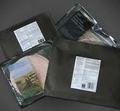



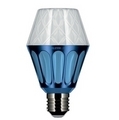




Comments by our Users
Be the first to write a comment for this item.